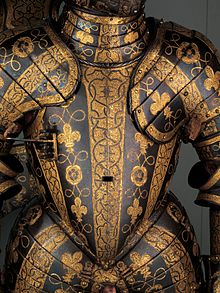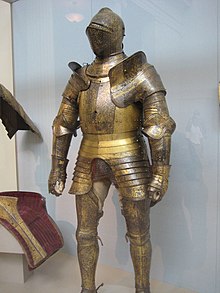
Greenwich armour is the plate armour in a distinctively English style produced by the Royal Almain Armoury founded by Henry VIII in 1511 in Greenwich near London, which continued until the English Civil War. The armoury was formed by imported master armourers hired by Henry VIII, initially including some from Italy and Flanders, as well as the Germans who dominated during most of the 16th century. The most notable head armourer of the Greenwich workshop was Jacob Halder, who was master workman of the armoury from 1576 to 1607. This was the peak period of the armoury's production and it coincided with the elaborately gilded and sometimes coloured decorated styles of late Tudor England.
As the use of full plate in actual combat had declined by the late 16th century, the Greenwich armours were primarily created not for battle but for the tournament. Jousting was a favourite pastime of Henry VIII (at dire cost to his health), and his daughter Elizabeth I made her Accession Day tilts a highlight of the court's calendar, focused on hyperbolic declarations of loyalty and devotion in the style of contemporary verse epics. Even late in her reign, courtiers gained favour by participating and dressing the part.
The workshop produced bespoke armour for the nobility; relatively mass-produced government orders for the military mainly went elsewhere. The book of Greenwich armour designs for 24 different gentlemen, known as the "Jacob Album" after its creator, includes many of the most important figures of the Elizabethan court. In this period a distinctive Greenwich style developed, marked by imitating aspects of fashionable clothing styles, and extensive use of gilded and coloured areas, using complex decoration in Northern Mannerist styles.

By the mid-17th century, plate armour had adopted a stark and utilitarian form favoring thickness and protection (from the ever-more-powerful firearms which were redefining battle) over aesthetics and was generally only used by heavy cavalry; afterwards, it was to disappear more or less completely. Therefore, the Greenwich workshop represented the last flourishing of decorative armour-making in England, and comprises a unique genre of late-Renaissance art in its own right.
